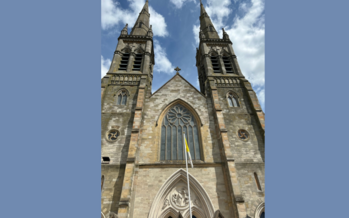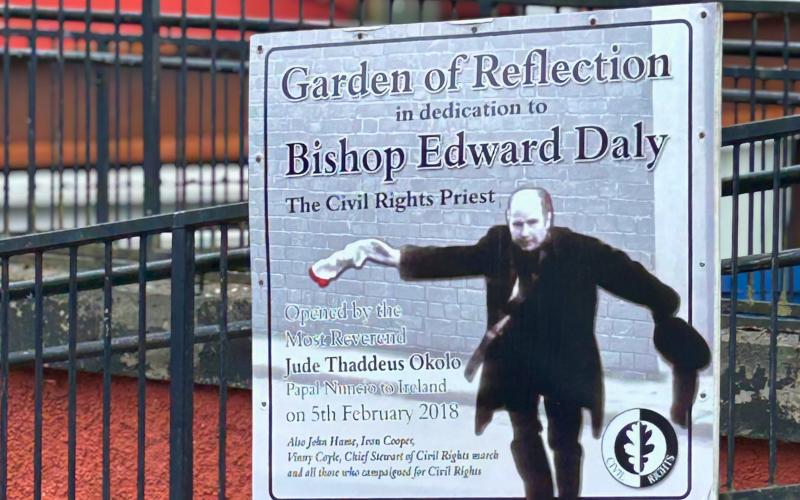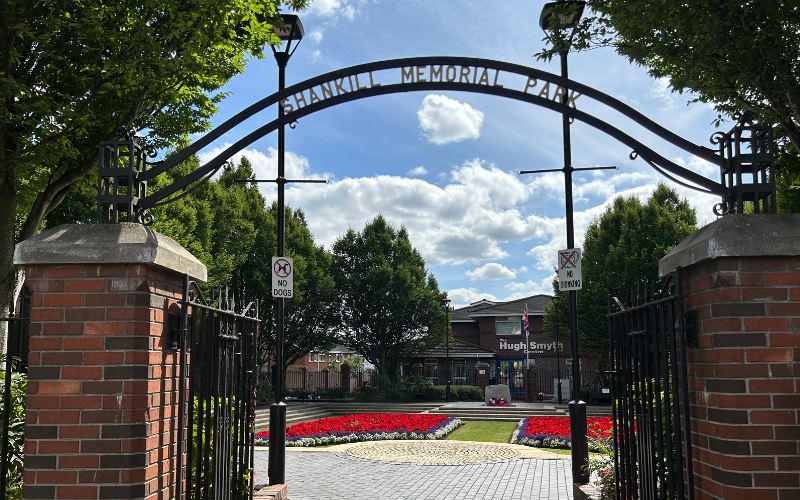-
 July 15, 2025By Bishop Gerald Kicanas
July 15, 2025By Bishop Gerald Kicanas
Summer greetings from our second stop in our visit to Northern Ireland. This past week we toured the Walled City of Derry, also referred to as Londonderry. It is the site of the “Batte of the Bogside” (1969) and Bloody Sunday (1972) and the tragic conflict with English soldiers that took the lives of many innocent people. On the road from Belfast to Derry there were a number of signs indicating directions to Londonderry. Many of the signs which had the word Londonderry had London crossed out. The Nationalists (Catholics) refer to the place only as Derry while the Loyalists (Protestants) speak of Londonderry. Even today there are Protestant enclaves and Catholic Enclaves and never the twain shall meet.
Unlike Belfast, Derry has stark mementoes of the “troubles” especially the tragic event of “Bloody Sunday.” The English soldiers claiming the protesters carried guns and bombs killed about 15 innocent people, who were innocent protesters carrying neither guns nor bombs. It was a peaceful protest imitating the Civil Rights marchers in the States. For too long the Nationalists (Catholics) were contained in slum areas in what was called the Bog, a low-lying area outside the walled city where the Loyalists (Protestants) lived.
Education and the Civil Rights Movement encouraged the Nationalists to protest and speak up about the discrimination they were facing. And stand up they did. The English paratroopers who were called in to quell the protesters got violent and shot innocent participants. The truth forum held in the Guild Hall within the walls, was established to determine fault in the Bloody Sunday deaths concluded, after prolonged negotiations and testimony, that those killed by the English Soldiers were innocent. The soldiers were at fault firing into and killing innocent people. These soldiers have yet to pay for their crimes. The English Prime Minister apologized for the taking of innocent lives by the soldiers which brought some comfort. The city of Derry, unlike Belfast, has many mementoes of Bloody Sunday. Murals abound in the city along with calls for an end to discrimination in Palestine and other places throughout the world. The people of Derry have experienced discrimination and violence and so have great empathy toward communities experiencing the same around the world. They call for peace and respect and regard for the varied cultures to live together in respect for one another. One mural shows boxes of equal size yet different colors with a dove of peace overlying them. The message is we are all equal and need to uphold the dignity of all. Another mural shows images of Nelson Mandela, Martin Luther King Jr., Mother Teresa of Calcutta, and John Hume, who negotiated the peace agreements in Northern Ireland. Another mural shows Fr. Edward Daly who later became Bishop of Derry holding a white handkerchief asking solders not to shoot after they killed a bystander with Fr. Daly. The soldiers kept firing their rifles. Fr. Daly was a priest among his people.
The city of Derry, unlike Belfast, has many mementoes of Bloody Sunday. Murals abound in the city along with calls for an end to discrimination in Palestine and other places throughout the world. The people of Derry have experienced discrimination and violence and so have great empathy toward communities experiencing the same around the world. They call for peace and respect and regard for the varied cultures to live together in respect for one another. One mural shows boxes of equal size yet different colors with a dove of peace overlying them. The message is we are all equal and need to uphold the dignity of all. Another mural shows images of Nelson Mandela, Martin Luther King Jr., Mother Teresa of Calcutta, and John Hume, who negotiated the peace agreements in Northern Ireland. Another mural shows Fr. Edward Daly who later became Bishop of Derry holding a white handkerchief asking solders not to shoot after they killed a bystander with Fr. Daly. The soldiers kept firing their rifles. Fr. Daly was a priest among his people.
Upon our return to Belfast, we spent the day walking along Falls Road and Shankill Road where much of the “troubles” took place. Falls Road is the Catholic area, those wanting a unified Ireland and the British to leave. Shankill Road is the Protestant area, the loyalists, very committed to staying a part of Britain. The two areas are very close to one another yet far from one another. The areas were separated by a wall. These two streets communicate two vastly different narratives.
Walking down Falls Road, you see Republic of Ireland flags. There are countless murals honoring the innocent civilians killed by British soldiers. They depict soldiers breaking down the doors of households, to set them on fire or arrest the occupants. There is a memorial garden along the street, honoring the members of the Irish Revolutionary Army who gave their lives to end the English occupation. Along the street you see many Palestinian flags and posters calling for an end to the Israeli occupation of Palestine. Similarly, there are signs calling for the liberation of other people, past and present, like the apartheid in South Africa. Clearly along Falls Road there are cries on behalf of people who are being discriminated against not unlike those who were seeking independence from England. Falls Road expresses empathy for all experiencing repression.
Along the street you see many Palestinian flags and posters calling for an end to the Israeli occupation of Palestine. Similarly, there are signs calling for the liberation of other people, past and present, like the apartheid in South Africa. Clearly along Falls Road there are cries on behalf of people who are being discriminated against not unlike those who were seeking independence from England. Falls Road expresses empathy for all experiencing repression.
Along Falls Road, you see St. Patrick Cathedral with its tall spires easily seen from Falls Road and Shankill Road, showing how close the two areas are to one another.
We crossed over to the Shankill Road which is a mere few blocks from Falls Road. Suddenly you are overwhelmed by British flags and murals depicting the British soldiers and loyalists who were killed by the brutal forces of the Irish Republic Army. Along the street there is also a Garden of Remembrance but on Shankill Road to the innocent soldiers and loyalists who died.
Shankill Road residents were getting ready for a big celebration and parade that took place July 12 remembering the Battle of the Boyne, a battle in 1690 in which King William and his Protestant forces conquered King James and his Catholic forces. The Catholics, they say, do not participate. Huge bonfires are set near the parade route and the celebrations along Shankill Road take over the area. We can learn a lot from the “troubles” that occurred in this area. When people are divided, set against one another, told different narratives, they turn against one another. When we see the other as “the other” we set up walls, segregate from one another, no longer see each other as sisters and brothers but as enemies, those different from us, those opposed to us, inferior to us, that leads to conflict and division.
We can learn a lot from the “troubles” that occurred in this area. When people are divided, set against one another, told different narratives, they turn against one another. When we see the other as “the other” we set up walls, segregate from one another, no longer see each other as sisters and brothers but as enemies, those different from us, those opposed to us, inferior to us, that leads to conflict and division.
They tell us the divisions are breaking down, especially among the young who go to pubs together, enjoy music together, dance together. While among the older population, the division perdures. Many believe that in 10 years, more or less, Ireland will become united, and England will no longer be involved. Time will tell.
